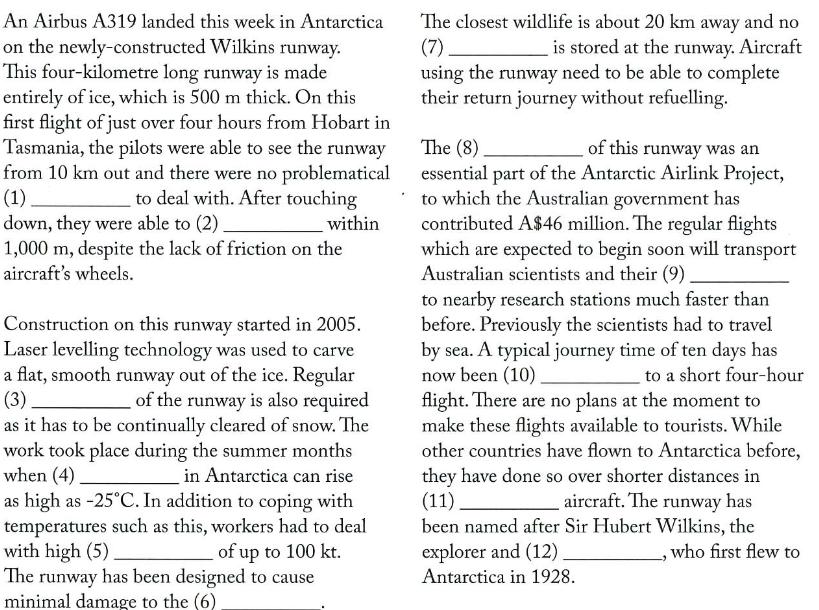
- •Методичні вказівки щодо виконання самостійної роботи
- •1 Загальні положення
- •Тематичний план самостійної роботи
- •3 Методичні вказівки під час роботи з текстом
- •4 Методичні вказівки щодо виконання самостійної роботи
- •Тема 10
- •Тема 11
- •Тема 12
- •Тема 13
- •Тема 14
- •Тема 15
- •Тема 16
- •Тема 17
- •Тема 18
- •Тема 19
- •Тема 20
- •Модуль 4 «Загальні правила ведення радіообміну англійською мовою»
- •Модуль 5 «doc icao 9432 Керівництво по радіотелефонному звязку»
- •Модуль 6
- •Тема 1 Стандарти ікао щодо мовної компетенції авіаційних спеціалістів (icao Language Proficiency Standards).
- •Тема 2. «Airports and runways»
- •Тема 3. «Navigation and flight planning»
- •Тема 4 «Aviation technology»
- •Тема 5. «Animal hazards in aviation»
- •Модуль 8 «Авіаційна англійська мова (2)»
- •Тема 6 «Different ways to fly»
- •Тема 7. «Health and flying»
- •Тема 8 «Fire on board»
- •Тема 9. «Weather»
- •Модуль 9 «Помилки, які допускає авіаційний персонал під час спілкування англійською мовою»
- •Тема 10. «Landing an aircraft»
- •Тема 11. «Fuel consumption and environmental issues»
- •Тема 12. «Pressurization and depressurizations»
- •Тема 13. «Security in Aviation»
- •5 Перелік навчально – методичної літератури
Модуль 9 «Помилки, які допускає авіаційний персонал під час спілкування англійською мовою»
Тема 10. «Landing an aircraft»
Питання для самостійного вивчення:
вивчення лексики професійного спрямування до тексту;
читання тексту;
переклад тексту;
знаходження знайомих граматичних форм і конструкції;
розуміння змісту прочитаного;
підготовка до обговорення тематичного матеріалу тексту;
огляд рекомендованої літератури, бібліографічних і довідкових джерел, преси англійською мовою.
Завдання для самоконтролю знань
1.
Read
and complete the text with the words in the box:
![]()

Рекомендована література
1.2, 1.3, 2.1, 2.2, 2.3, 2.9, 2.11, 2.12, 2.13.
Тема 11. «Fuel consumption and environmental issues»
Питання для самостійного вивчення:
вивчення лексики професійного спрямування до тексту;
читання тексту;
переклад тексту;
знаходження знайомих граматичних форм і конструкції;
розуміння змісту прочитаного;
підготовка до обговорення тематичного матеріалу тексту;
огляд рекомендованої літератури, бібліографічних і довідкових джерел, преси англійською мовою.
Завдання для самоконтролю знань
Read
the problems and take a role:




Рекомендована література
1.2, 1.3, 2.1, 2.2, 2.3, 2.9, 2.11, 2.12, 2.13.
Тема 12. «Pressurization and depressurizations»
Питання для самостійного вивчення:
вивчення лексики професійного спрямування до тексту;
читання тексту;
переклад тексту;
знаходження знайомих граматичних форм і конструкції;
розуміння змісту прочитаного;
підготовка до обговорення тематичного матеріалу тексту;
огляд рекомендованої літератури, бібліографічних і довідкових джерел, преси англійською мовою.
Завдання для самоконтролю знань
Drama as pilot is sucked out of plane at 23.000ft
The June 1990 incident in which a British Airways Captain Timothy Lancaster was almost blown out of the cockpit of a British Aerospace One – Eleven (BAC – 1 – 11) by the explosive decompression following a windscreen section failure at 23,000 ft is a classic example of the danger of human error in maintenance.
Despite wearing a lap-strap, the pilot was saved from death only when a steward Nigel Ogden managed to grab his legs as he was being sucked out of hole in the nose of the plane. The force of the blast blew open the cockpit door behind him. Captain Lancaster had been dragged out of his seat by force of pressurized cabin air leaving the airplane.
But the force of air on the plane was too strong for the cabin crew to pull Captain Lancaster back in. As they struggled to hold on to him for 15 minutes, Co-pilot Alister Atcheson made a “Mayday” call and dived the plane downwards. He landed the aircraft at Southampton Airport with the pilot still hanging out of the plane.
During his 18 minute ordeal Captain Lancaster had to face a temperature of minus 32 degrees Centigrade – as well as a chill factor from the wind that made it much colder. He was treated in hospital for frostbite, severe shock, cuts, bruises and a broken elbow, wrist and thumb.
The windscreen was new and had been put in just two days earlier during regular checks on the airplane. A British Airways outstation shift-maintenance manager had used under-sized retaining bolts to secure the windscreen. The replacement windscreen had been installed with 84 bolts, the diameters of which were 066 mm less than the diameters of the specified bolts, and six bolts which were of the correct diameter, but 2,5 mm too short.
The windscreen fitting process was characterized by a series of poor work practices, poor judgements and perceptual errors, each one of which eroded the factors of safety.
Although an independent final inspection would have had a high probability of detecting the error, the task of the windscreen installation was not designated a “vital point” and, consequently, no duplicate inspection was called for and none took place.
Термінологічний словник
to suck высосать;
to save cпасать;
to dive нырять; пикировать;
chill холод, холодный;
death смерть; смерть;
to struggle бороться;
ordeal испытание;
strong сильный;
to drag тащить(ся);
explosion взрыв;
bone кость;
stage стадия; этап;
regular регулярный;
nature природа, характер;
explosive взрывной,(зд.); резкий, мгновенный;
shock шок;
frostbite отморожение (отмороженное место);
to injure повредить, повреждение;
force сила;
despite вопреки;
lap strap привязные ремни;
to grab схватить
cuts порезы;
bruises синяки (ушибы);
maintenance manager руководитель техников;
to retain удерживать;
to secure закреплять;
replacement замена;
to install устанавливать;
to fit подгонять;
judgement суждение;
perceptual ощутимый;
to erode разрушать
detect расследовать.
Рекомендована література
1.2, 1.3, 2.1, 2.2, 2.3, 2.9, 2.11, 2.12, 2.13.
